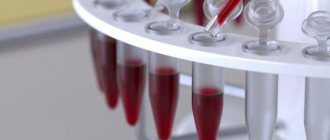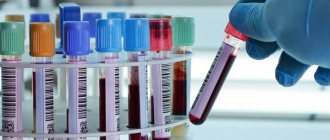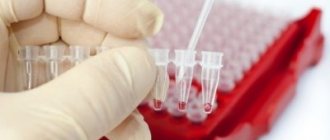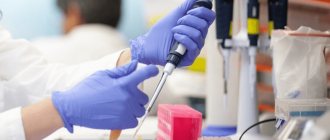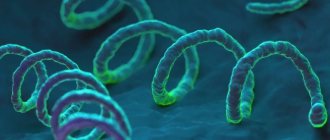What is this analysis?
In the body, in response to the introduction of pathogenic microflora or when its own cells are damaged, special protein elements are formed - antibodies. When diagnosing syphilis using the microreaction method (MRP) in the patient’s blood, they try to find the connection between antibodies and phospholipids - proteins that make up all cell membranes.
An immune response in the form of antibody production is formed precisely when phospholipids from cell membranes enter the blood. This occurs when Treponema pallidum, the causative agent of syphilis and a number of other infections, penetrates human tissue.
It takes a certain amount of time for antibodies to begin to be produced when infected with syphilis. This does not happen instantly, but, at the earliest, 3-4 weeks after infection. This is why this test is not suitable for early diagnosis. But due to the ease of implementation and low cost, MRP is classified as a screening test designed to detect the disease among the general population.
Diagnosis of syphilis using this method consists of the following steps:
- preparing the patient for collecting material;
- donating blood in the laboratory. The analysis requires patient blood, which is most often taken from a vein, but in some medical institutions it is also used from a finger;
- using special equipment, blood plasma is separated from cellular elements;
- An antigen with a visualizing agent is added to the resulting biological fluid. Coal is most often used for this;
- If phospholipid antibodies are present in the serum, they stick together with the introduced antigen, which is manifested by the formation of black flakes, indicating a positive reaction. In the absence of antibodies to phospholipids in the body, flakes are not formed.
A quantitative assessment of the presence of Treponema pallidum in the body is also carried out with the calculation of titer indicators. For this purpose, microreactions to syphilis are performed in dilutions. During the research process, the patient's blood serum is diluted with saline solution, first twice, then four times, and so on, each time doubling the dilution and conducting a test to detect antibodies in the material. In this case, the dilution at which the microreaction last remained positive is noted. For example, 1:320 means that even with a dilution of 320 times, the blood serum still contains antibodies. This figure is an indicator of the titer and is indicated in the analysis. The higher the titer value, the more active the pathological process in the body.
Quantitative determination of the titer is important for monitoring the effectiveness of therapy and diagnosing the final cure of syphilis. Within a year after course therapy, there should be a 4-fold drop in titers. Control tests are carried out 3 months, six months and a year after treatment.
How is syphilis diagnosed?
The diagnosis of syphilis is made on the basis of a combination of history, confrontation, clinical picture and laboratory data, including detection of the pathogen and the results of a serological examination. Confirmation of the diagnosis by laboratory data is mandatory.
In case of complete inability to use laboratory diagnostic methods for syphilis, the World Health Organization (1999) and the Ministry of Health of the Russian Federation (order No. 327 of July 25, 2003) allow the use of so-called syndromic (epidemiological) treatment of syphilis based on clinical and anamnestic data.
Diagnostic methods confirming the presence of syphilis
Confirmed diagnosis of syphilis in a sexual partner Casual sexual intercourse without barrier protection during the period corresponding to the incubation period Previous presence of rashes in the genital area, enlarged lymph nodes
Inspection of the genital organs, skin, oral mucosa, anus Palpation of eruptive elements if present Palpation of peripheral lymph nodes
The presence of skin and mucous membrane lesions characteristic of different periods of syphilis. Enlarged lymph nodes
Detection of T. pallidum in material from lesions, lymph nodes, amniotic fluid, cerebrospinal fluid
Detection of typical forms of treponema
Presence of fluorescent treponemes
Detection of T. pallidum specific DNA
Non-treponemal serological tests - detection in blood serum of antibodies against phospholipids of tissues destroyed by syphilitic infection and membrane lipids of T. pallidum
Macroscopic test Rapid Plasma Reagins (RPR) test
Microscopic test VDRL (Venereal Disease Research laboratory) Quantitative test VDRL
Treponema serological tests - detection of antibodies against Treponema pallidum antigens in blood serum
Positive (positive) result
Diagnostic methods confirming the presence of various forms and complications of syphilis
Forms and complications
X-ray of the aorta, long tubular bones, sternum, skull bones, joints
Early congenital syphilis Late congenital syphilis Tertiary syphilis
Acoustic neuritis Syphilitic labyrinthitis
Optic neuritis Parenchymal keratitis
Routine research methods are also used - general blood and urine tests, biochemical blood tests, etc.
Indications for the study
Precipitation microreaction to syphilis is performed for diagnostic purposes and during screening studies. To identify and confirm the presence of Treponema pallidum infection, MRP analysis is prescribed to the following groups of patients:
- having clinical manifestations of the disease. First of all, these are patients with characteristic ulcerations on the genitals and areas of the body that come into contact with a partner during sexual intercourse. Attention is also drawn to enlarged lymph nodes located close to the lesion;
- persons with any rashes or sores in the genital area;
- sexual partners and family members of the patient;
- newborns born to mothers who are sick or have a history of syphilis;
- patients with any other pathology transmitted through intimate contact.
The study is also carried out for persons who do not have pronounced symptoms, but are presumably suffering from syphilis. This is due to the fact that when an infection is suspected, sometimes people do not consult a doctor, but instead begin to treat the disease with antibiotics. This leads to the fact that the manifestations of the pathology go away, but treponema pallidum remains in the body, and the disease proceeds in a latent form. Since it is very difficult to visually diagnose syphilis in such a situation, the doctor prescribes a laboratory blood test.
Also, MCI for syphilis is regularly carried out for military personnel, employees of public catering, healthcare and education institutions. This analysis is mandatory for pregnant women, donors, and patients with surgical pathology before surgery.
To monitor the effectiveness of the treatment, all infected patients are regularly examined. Persons who have undergone treatment for syphilis also periodically donate blood within a year after recovery to determine the titer of the pathogen. Once the infection is completely cleared, the reaction becomes negative over time.
Symptoms
Incubation is characterized by the migration of bacteria through the lymphatic and blood vessels and their active reproduction in the lymph nodes. The duration of the period is from 3 weeks to 3 months.
- In patients, a dense, painless, reddish nodule appears at the site where the bacterium invades, which turns into an ulcer, which is called chancre. This skin lesion is located on the penis, labia, urethra, mouth, vagina, near the anus, on the skin of the mammary glands, lower abdomen, and fingers. The size of the ulcer can vary from dwarf - the size of a poppy seed - to gigantic. They are multiple, bipolar and single. In almost all patients, the lymph nodes in the area of infection, usually the inguinal ones, become enlarged.
- 10 weeks after the onset of chancre, secondary syphilis occurs, which is characterized by generalization of infection. Microbes enter the blood and disseminate hematogenously throughout the body. In internal organs, the spirochete causes specific inflammation. A symmetrical pink rash appears on the skin, which is secondary syphilides. They appear in attacks, disappear without treatment, and then appear again.
syphilitic rashThe rash in secondary syphilis is roseolous, papular or pustular. Intoxication signs develop: fever, fatigue, weakness, symptoms of pharyngitis, myalgia, arthralgia, sudden weight loss. The secondary form of the pathology is characterized by erythematous tonsillitis, angular stomatitis or cheilitis, generalized lymphadenitis, leukoderma, alopecia, and the appearance of condylomas lata on the genitals. If complex treatment is not carried out at the first or second stage, then after a few years the third stage of syphilis will occur, manifested by damage to the cranial and peripheral nerves.
- The tertiary form of syphilis occurs 3-15 years after the initial infection. It can occur with the formation of many gummas and foci of destruction, such as neurosyphilis, cardiovascular or visceral syphilis. Irreversible disturbances in the functioning of internal organs and systems develop. In patients, the process of swallowing, speech, and breathing is disrupted, perforation of the hard palate occurs, and the nose “falls in.” This period of illness usually ends with the patient's disability or death.
Congenital syphilis develops as a result of intrauterine infection of the fetus. This severe pathology is manifested by a characteristic triad of symptoms in a child: congenital deafness, keratitis, Hutchinson teeth.
How to properly prepare for the analysis?
In order to obtain correct results of the precipitation microreaction when testing for syphilis, a number of conditions must be met for some time before visiting the laboratory. Recommendations for preparing for donating blood for syphilis include the following points:
- Be sure to inform the doctor about all existing concomitant diseases. The presence of certain pathologies may distort the results;
- To get the correct results, give your doctor a list of all medications prescribed by other specialists that you are currently taking. You may need to cancel for a week or make adjustments to the treatment regimen;
- a week before visiting the laboratory, you must stop taking any medications that have antibacterial, antiviral or antifungal effects;
- three days before submitting the material, stop drinking any drinks containing alcohol, even in minimal quantities;
- the day before the study, fatty, spicy, smoked and fried foods are excluded from the diet;
- An hour before the test, you must completely stop smoking.
Blood is donated in the morning on an empty stomach. Until this time, you can only drink pure still water.
With proper preparation for the study, the risk of obtaining false positive results is significantly reduced. Therefore, it is necessary to strictly follow all the recommendations of the attending physician before conducting the study.
How to interpret syphilis tests
In world medical practice, three reactions are used to diagnose syphilis: a non-treponemal test - RPR or VDRL and two treponemal tests - an immunofluorescence reaction (RIF-FTA) and a passive hemoagglutination reaction (RPHA - TPHA)
no syphilis or incubation period or very early stage
untreated or recently treated syphilis
primary syphilis or false-positive RPR and RIF
false positive RPR and RPGA or false negative RIF
treated syphilis or untreated late syphilis
biological false positive reaction
early primary syphilis or recently treated syphilis or false-positive RIF
treated syphilis or false-positive RPHA
In Russia, the compliment binding reaction (Wassermann reaction) and the immobilization test of Treponema pallidum (RIBT) are also used to diagnose syphilis.
During the primary seronegative period of syphilis, there are positive RIF and Ig ELISA as the most sensitive seroreactions. However, this is not a basis for diagnosing such patients with primary seropositive syphilis. A number of patients during this period have an isolated positive result when testing the Wasserman reaction with treponemal or cardiolipin antigens. At the end of the 3rd or during the 4th week after the appearance of chancre, standard serological reactions become positive - from this moment the primary seropositive period of syphilis begins. At 1-2 weeks of primary seropositive syphilis, there is an increase in the degree of positivity of the seroreaction (1+, 2+, 3+) and an increase in the reagin titer (1:5, 1:10, 1:20). RIF and ELISA already give a sharply positive result in all patients, but RIBT is usually negative or the percentage of immobilization is very low. The diagnosis of primary seropositive syphilis is also made for those patients in whom sediment reactions and the Wasserman reaction with nonspecific antigens gave even a single weakly positive result. With the further course of primary syphilis, all serological reactions become sharply positive (4+); the reagin titer reaches 1:80, 1:160, RIF continues to be sharply positive, but RIBT in most patients still remains negative or may become weakly positive.
With secondary fresh syphilis, a sharply positive result for all standard serological reactions is observed in almost 100% of cases; the titer of reagins is the highest - 1:160; 1:240 or 1:320. RIF – 4+; RIBT gives a positive result in more than half of the patients, but the percentage of treponeme immobilization is low (40-60%). With secondary recurrent syphilis, a positive result according to standard serological reactions is observed in 96-98% of cases. Negative results can sometimes be explained by an asymptomatic recurrent course, the presence of asthenia and a combination of syphilis and HIV infection. RIBT gives a positive result in 85-90% of patients with a pronounced degree of immobilization - 80-90-100%.
Tertiary syphilis is characterized by positive results according to standard serological reactions in 50-90% of cases and positive RIBT in 92-100% of patients with a high percentage of immobilization.
The diagnosis of latent seropositive syphilis, as mentioned above, is established only by positive seroreactions in the blood with mandatory confirmation of them by RIBT, since only RIBT (and to a lesser extent RIF) allows one to differentiate false-positive seroreactions (even with a positivity of 2+ or 3+) from truly positive.
Neurosyphilis and visceral syphilis
Different forms of syphilis of the nervous system and visceral syphilis have different frequencies and expressiveness of standard seroreactions. Thus, progressive paralysis in 100% of cases is accompanied by sharply positive all standard serological reactions. Syphilis of the cerebral vessels, tabes dorsalis, and syphilitic lesions of the cardiovascular system are accompanied by positive seroreactions only in 40-50-60% of observations. However, RIBT in almost all of the listed pathological conditions gives a sharply positive result (90-100% immobilization).
When diagnosing congenital syphilis in the first 2 months after birth, standard serological reactions in a child are not determined, since they can be positive due to the passive transmission of reagins through the placenta. For the same reason, a positive RIBT result does not matter. Immobilins passively transmitted from mother to child disappear spontaneously within 6 months after birth. If a child becomes infected shortly before birth, then in this case the RIBT will still be negative (due to the later formation of immobilisins), despite the presence of a syphilitic infection in the child’s body. With congenital syphilis of infants with active manifestations, standard seroreactions can be negative in 1% of observations. With congenital syphilis of early childhood, negative standard seroreactions vary from 15 to 20%, but in these cases, RIBT gives positive data in 90-98% of children. With late congenital syphilis, even in the presence of active manifestations, standard seroreactions are found only in 70-80% of those examined, but RIBT is clearly positive in 100% of patients with a high titer of immobilisins.
Reasons for possible errors
Sometimes the study produces false positive results. The “correctness” of the conclusion is influenced by a number of external and internal factors.
First of all, to understand the cause of a false-positive result, one must keep in mind that the microreaction to syphilis is not a treponemal analysis. The study does not identify Treponema pallidum itself or its metabolic products. This means that similar antibodies to phospholipids can be formed in other diseases in which the integrity of cells in the human body is disrupted.
- various injuries;
- conditions after surgery;
- allergic diseases;
- hives;
- systemic lupus erythematosus;
- acute respiratory diseases;
- pregnancy.
It is also possible to distort the results with pneumonia, viral hepatitis, infectious mononucleosis, and diabetes mellitus. The study is influenced by the presence of autoimmune pathologies, oncological pathologies, tuberculosis infections, and antiphospholipid syndrome in the patient.
A false positive reaction is also observed when taking cytostatic drugs, endocrine pathologies and metabolic disorders. That is why, if the microprecipitation reaction is positive, an additional set of tests for syphilis is prescribed.
Also, the final result of the study is influenced by such factors as the blood sampling technique, in which air bubbles may remain in the biological material, storage and transportation of the analysis directly to the laboratory. Proper pre-treatment of laboratory glassware and the shelf life of the reagents used are also important. The results are also affected by the errors of medical personnel during the study. Such errors include refusal to use control blood sera, insufficient mixing of the antigen in the emulsion, and the use of disubstituted citric acid salts instead of trisubstituted ones.
A positive MRI response serves as a signal for a more complete and careful additional examination of this patient.
Treponema pallidum
Morphology
Treponema pallidum is a gram-negative microorganism that has the shape of a thin spiral twisted into 8-12 small curls. Treponema pallidum received its name due to its ability to not perceive conventional laboratory dyes.
The spirochete is a strict anaerobe that grows well in an oxygen-free environment. But despite this, the viability of bacteria remains on surrounding household objects for 3 or more days. Treponema has flagella and fibrils. Thanks to them and the cell’s own contractions, the bacterium makes translational, rotational, flexion, wave-like, helical and contractile movements. It quickly penetrates living cells and rapidly multiplies in them by transverse division.
Treponema pallidum has a three-layer cell wall, cytoplasm and organelles: ribosomes, mesosomes, vacuoles. Ribosomes synthesize proteins, and mesosomes provide respiration and metabolism. Enzymes and antigens are contained in the cytoplasmic membrane. The body of the bacterium is covered with a mucous, structureless capsule that performs a protective function.
Physical properties
Microbes are resistant to low temperatures and sensitive to high temperatures. When heated they die within 20 minutes, when dried within 15 minutes, and when boiled - instantly. Antiseptics and disinfectants quickly destroy Treponema pallidum. The following have a detrimental effect on the bacterium: ultraviolet radiation, light, alcohol, alkalis, vinegar, arsenic, mercury, and chlorine-containing disinfectants. Treponema pallidum is resistant to some antibiotics.
Treponema pallidum exhibits its pathogenic properties in a humid and warm environment. In the human body, the favorite place of reproduction is the lymph nodes. At the stage of secondary syphilis, microbes concentrate in the blood and exhibit their pathogenic properties.
Cultural properties
Treponema pallidum does not grow on artificial nutrient media, in cell culture or in chicken embryos. It is cultured in rabbit testicles. In these cells, the microbe grows and multiplies well, fully retaining its properties and causing orchitis in the animal.
There are enriched nutrient media designed to isolate pure culture. Microbes grow on them under a thick layer of petroleum jelly. In this way, antibodies necessary for staging specific reactions to syphilis are obtained.
Treponemas grow on blood or serum agar in an oxygen-free environment. At the same time, they lose their pathogenic properties, but retain their antigenic properties. Pathogenic treponemes are able to ferment mannitol, utilize lactate and form specific metabolites.
Pathogenicity
Factors and components of pathogenicity and virulence of bacteria include:
- Adhesin proteins that ensure fixation of the microbe on the host cell,
- Myofibrils, which promote deep penetration into the body and migration of bacteria in the host body,
- Formation of L-forms,
- Lipopolysaccharides of the outer membrane,
- Fragments of pathogenic cells penetrating deep into tissues
- The ability to penetrate into the intercellular junctions of the endothelium,
- Antigenic variability.
Treponema pallidum has a direct toxic effect on the synthesis of macromolecules - DNA, RNA and proteins. T. pallidum antigens are used in the Wassermann reaction for the serodiagnosis of syphilis. Under unfavorable conditions, the spirochete is transformed into L-forms, which ensure its resistance to antibacterial agents and antibodies.
Decoding the results
Only the attending physician can decipher the microreaction of precipitation to syphilis, taking into account the data of the anamnesis and visual examination. As a result of the study, the laboratory can provide three answer options:
- positive reaction. This conclusion implies that the patient has latent, primary, secondary or tertiary syphilis. Also, such a response may indicate a persistent, persistent positive reaction to serological examinations, which occurs in approximately 10% of people completely cured of syphilis. False-positive variants should not be overlooked;
- negative reaction. It is noted not only in the absence of the disease, but also in the later stages of the development of pathology or with primary syphilis. This result can also be a false negative response in the case of a very high concentration of antibodies in the test material;
- questionable reaction. Placed in cases of low antibody titres.
During and after treatment, quantitative indicators of the activity of the syphilis pathogen are also assessed. Thus, with a positive reaction, the antibody titer ranges from 1:2 to 1:320. If the answer is negative, antibodies are not detected. A questionable reaction is observed at low titres. Complete cure is diagnosed only if the antibody titer drops by 4 times over the course of a year.
All questionable results require additional tests using other methods - passive hemagglutination reaction, immunofluorescence, anticardiolipin test.
What are treponemal tests
As with non-treponemal tests, treponemal tests use an immunological antigen-antibody reaction. But treponemal antigens are used as antigens - either intact treponemes or purified and ultrasonified treponemes or recombinant antigens. To conduct and detect the results of the antigen-antibody reaction, more complex and expensive ones are used various methods. The most commonly used treponemal tests are:
- Immunofluorescence reaction (RIF-FTA) in various modifications
- Passive agglutination reaction (RPHA - TPHA)
- Enzyme-linked immunosorbent assay (EIA) including recombinant ELISA
- Treponema pallidum immobilization reaction (TPI)
- Immunoblotting
Where can I get tested?
A blood test using the MRP method is performed by a clinical laboratory. To obtain a referral, you should contact a dermatovenerologist at your local clinic or a dermatovenerological dispensary. Commercial diagnostic and laboratory centers will help you conduct research on conditions of complete anonymity.
Only a dermatologist-venereologist makes a final diagnosis and carries out specific treatment. If necessary, to prescribe the most effective course of therapy, the attending physician may involve other specialists for consultation:
For an adequate choice of medications in the presence of concomitant diseases, you may also need the opinion of a highly specialized doctor.
You can become infected with syphilis not only from your sexual partner, but also through household means. For early diagnosis of the disease, if infection with Treponema pallidum is suspected, it is necessary to do a screening test as soon as possible and, if syphilis is suspected, consult a doctor to clarify the diagnosis and receive treatment.
«>
Source: 1poserdcu.ru
Microreaction to syphilis refers to non-treponemal tests, which are based on an immunological reaction between antibodies and antigens. The microprecipitation reaction to syphilis is designed to determine reagin antibodies in the patient’s blood, the production of which is a response to damage to lipids by Treponema pallidum. However, due to the fact that miroprecipitation is aimed at searching for antilipid antibodies, this test cannot be considered confirming the presence of syphilis. The correct direction would be for this analysis as a screening test. This situation is due to the fact that in addition to syphilis, MRI will detect antibodies in the case of many other human conditions and diseases that are accompanied by the destruction of body tissue. Therefore, the microreaction is usually used as a marker and combined with treponemal tests to obtain a more accurate result.
Microprecipitation gets its name due to the need for only a small amount of reagents and test material to carry out the reaction, from the Latin word Precepitacio, meaning fall. In this case, it is the precipitation of antigen antibodies in the form of flakes.
According to their differences in the implementation of the MCI of syphilis, they are distinguished:
- Macroscopic test - results are assessed by eye;
- Microscopic test - to evaluate the results, a light microscope is used to count precipitants.
Typically, MRI for syphilis is used when it is necessary to conduct a routine examination of a certain group of the population, that is, when the simplicity, cheapness and speed of obtaining results from MRP testing are justified than the accuracy of the results obtained. The microreaction to syphilis is qualitatively carried out mainly when examining such persons as:
- Organ donors for transplantation
- Blood donors
- Pregnant women
- Food, health and education workers
- Prisoners
- Military personnel
- All those entering hospitals for inpatient treatment, as well as persons preparing for upcoming surgical interventions.
If the test results show the presence of Treponema pallidum in the body, then such a person is sent for further treatment to a hospital, and then registered at the clinic for a certain period of time. However, in order to discharge a patient from the hospital, it is necessary to make sure that he has recovered. Usually tests are carried out for this, but it’s not that simple. It is impossible to focus on external manifestations, knowing about the periods of latent course of the disease, and most tests can show the presence of treponema pallidum in the body for many years after successful treatment. In this case, a microreaction to syphilis is used, the negative result of which is one of the main criteria for successful treatment.
In the MRP analysis for syphilis, the results are assessed using a quantitative method, which allows, by comparing the range indicators before and during the start of therapy, to confirm the effectiveness of treatment when titers decrease or indicate the need to change medical tactics in the absence of positive dynamics. Thus, the microreaction to syphilis is qualitatively different from other serological studies, which can accurately indicate the presence of the disease, but not its dynamics or cure.
Not only venous blood or from a finger, but also cerebrospinal fluid can act as a material for microprecipitation. In the first two options, it is highly desirable that the collection of the test material be carried out on an empty stomach. With a lumbar puncture, refusal to eat before the test is not necessary. MR becomes positive within a month after the patient is infected, then with the development of the disease, titers will increase, but when they pass into a latent form, a decrease is observed, up to a complete negative reaction in tertiary syphilis. There can be three microreaction options:
- Positive – antibodies detected;
- Doubtful – low titers;
- Negative – no antibodies.
As already mentioned, microprecipitation can give a false-positive or false-negative result for syphilis. The reason for a false-negative MRI test is a high level of antibodies in the patient’s blood, which is very rare. The MRP will also show a negative result in the first weeks after infection, when the body has not yet produced the required amount of antibodies to Treponema pallidum. But the reasons for a false positive result are usually such body conditions as:
- Pregnancy;
- Non-venereal treponematoses;
- Diabetes;
- Antiphospholipid syndrome;
- Oncological diseases;
- Tuberculosis;
- Gout;
- Autoimmune diseases;
- Pneumonia;
- Viral hepatitis;
- Infectious mononucleosis;
- Chronic alcoholism and drug addiction.
Another reason for errors in microprecipitation is a violation of the research technique.
Reviews and comments
Leave a review or comment
Source: www.zppp.saharniy-diabet.com
What is serological diagnosis of syphilis
In most cases, it is impossible to detect the causative agent of syphilis or its detection is difficult. Therefore, to diagnose syphilis, so-called serological diagnostics are used, based on determining the various types and classes of antibodies that the body has produced in order to protect itself from a syphilitic infection, i.e., it is not the causative agent of the infection that is determined, but how the body reacted to its appearance. Serological testing (from the Latin serum - serum) is a laboratory analysis of capillary or venous blood plasma based on the immunological antigen-antibody reaction. As antigens, factory-made preparations are used that are similar in structure to the antigens of lipids that appear in the body during the destruction of tissues by the pallid spirochete, the lipids of its membranes and the specific molecular compounds that make up the membrane of the pallid spirochete (for these purposes, purified and ultrasonicated treponeme strains or isolated from them recombinant antigens). In laboratory conditions, the blood serum of the subject is added to the antigens. If antibodies are present in the blood serum (plasma), an antigen-antibody reaction occurs and its results are detected by various methods (positive result); in the absence of antibodies, the reaction does not occur (negative result). Serological diagnosis of syphilis is carried out in the following cases.
Screening for syphilis
Mass examination of certain population groups. For screening, cheap, simple and fast-performing test systems based on non-treponemal tests are used. The following are screened for syphilis:
- Pregnant women
- Blood and organ donors for transplantation
- Some professional contingents (food, education, health workers)
- Military personnel
- Persons serving sentences in prisons
- Patients preparing for surgical intervention
- Persons admitted for inpatient treatment (mandatory wassermanization - in Russia, CIS countries and some other countries)
To diagnose syphilis, a combination of non-treponemal and treponemal tests for syphilis or only treponemal (confirming) reactions are used. Serological examination for syphilis is prescribed in the following cases:
- Persons with clinical signs of syphilis
- Persons with any genital ulcers
- Persons who are sexual partners of patients with syphilis, as well as in the case of close household contact with a patient with secondary syphilis
- Children born from mothers with syphilis
- Persons with a confirmed diagnosis of other sexually transmitted infections
- To confirm screening results (selection reactions)
Monitoring the treatment of syphilis
Non-treponemal tests are used, so treponemal tests remain positive for a long time after treatment, and sometimes throughout life.
Blood test for microreaction
One type of non-treponemal tests is a microreaction to syphilis. This study is considered a rapid method and allows you to detect the presence of antibodies to Treponema pallidum. Such tests are used to screen large groups of the population, and after determining a positive test, additional testing is required.
What is a microreaction to syphilis and when should you get tested?
As soon as Treponema pallidum enters the human body, it begins to produce cardiolipin antigens, which trigger the development of antiphospholipid antibodies. This analysis is considered nonspecific, since it does not identify the pathogen itself, but examines the presence of a certain reaction of the body to syphilis.
It is important to note that the microreaction is a screening method that does not confirm the diagnosis, but only detects the presence of antibodies.
They occur not only with syphilis, but also with the development of tuberculosis, autoimmune disease or diabetes.
A microreaction of precipitation occurs when an emulsion of cardiolipin antigen is combined with the plasma or serum of a patient with syphilis; a flocculant is formed that looks like white snowflakes. To carry out the analysis, capillary blood is used - collected from a finger.
There are several types of microreactions:
- The microscopic test is carried out using a light microscope, under the magnification of which the number of precipitates is counted.
- Macroscopic test - involves counting with the naked eye, for this purpose a chemical substance is added that stains the antigen-antibody complex.
- A quantitative test involves multiple dilutions of biological material, followed by counting titers in each portion.
The most informative microreaction will be in the period from three weeks after the alleged infection.
How to prepare for the examination
To obtain accurate data, you need to prepare for the analysis. To do this, experts recommend adhering to the following rules:
- do not take antibiotics at least a week before donating blood,
- give up alcohol two days before the test,
- eliminate fatty and spicy foods from your diet a day,
- do not smoke an hour before the procedure,
- It is necessary to donate blood on an empty stomach.
You should refrain from getting tested if you have symptoms of a cold.
You should also tell your doctor if you have chronic diseases, diabetes, or pregnancy.
Evaluation of results - norms and deviations
- The formation of a large number of flakes is a positive reaction, which indicates the presence of any form of syphilis.
- The absence of flakes is a negative reaction, which confirms that the person being examined is healthy.
- The presence of small amounts of flakes is a borderline condition and is often considered a false positive. Usually occurs in the early stages of the disease or with the development of other ailments. Additional examination is required.
A false positive reaction occurs under the following circumstances:
- development of tuberculosis,
- pregnancy,
- recent infectious disease,
- viral hepatitis,
- diabetes,
- the presence of tumors in the body,
- with prolonged use of alcohol,
- drug addiction,
- autoimmune diseases.
There is also a false negative reaction, which occurs with a small amount of antibodies, this is associated with the early stage of development of syphilis. In situations where the test result is negative, but other signs of the disease subsequently appear, a consultation with a venereologist and additional serological tests are prescribed.
Probability of error
Precipitation microreaction (MR) to syphilis is considered a method for detecting syphilitic antibodies in the general population; this allows one to avoid epidemics and control the development of the disease, but despite its effectiveness, erroneous reactions are possible. This is often due to non-compliance with the research technique.
The result can be affected by incorrect blood sampling from a finger, non-compliance with the storage period of biological material, as well as violation of the temperature regime.
Using contaminated dishes or expired emulsion. Even minor changes in reagents or insufficient mixing of the material can contribute to erroneous results.
Despite the large number of nuances of the procedure, the microreaction to syphilis is considered a qualitative method that provides information about the presence of antibodies in 98% of cases. But an accurate diagnosis is only possible with additional diagnostics.
Price issue
On average, a screening test for syphilis costs about $7 in private clinics. The patient is also provided with complete anonymity. It is worth noting that commercial clinics will provide results within a few hours after blood collection.
State medical institutions can also carry out this testing, and on a free basis, but for this the patient must have a medical insurance policy and identification documents. He must visit a venereologist or therapist, who will write a referral for blood donation. The analysis result is usually ready no earlier than three days. And you can only get it at a doctor's appointment.
Often, the Ministry of Health funds screening of the population as part of preventing the spread of sexually transmitted diseases. Such events are announced in advance by the authorities, are anonymous and provide results in a short time.
Where to take a blood test for microreaction
There are several ways to screen your blood for syphilis:
- At home using rapid tests. This method is available at any time, the person remains anonymous, and the result of the study can be found out within 20 minutes. But there is an error in cases of false positive or false negative results.
- Contact a clinic or venereology clinic. The service will be provided free of charge, but the result of the analysis and referral will be obtained from the attending physician. This method has a smaller error than a home test, but the period for receiving analysis results can last up to three days.
- Visit a paid medical facility. This option assumes anonymity, the ability to pre-register for testing, and receive results in a short time. Receipt of the analysis report is discussed individually; in rare cases, it can be sent by email, but mostly it is provided in person.
Clinics such as Invitro and KDL have offices in all regional centers of the country and are ready to offer services for checking microreactions to syphilis. If you receive a positive result, you need to consult a doctor to clarify the diagnosis and prescribe treatment.
Source: veneromed.ru
Source: cardiolog.neboleite.com
What is immunoblotting
Immunoblotting (Western blot) to determine specific IgM or IgG is one of the modern and accurate methods for diagnosing syphilis. When performing immunoblotting, T. pallidum undergoes electrophoresis, resulting in the separation of protein immunodeterminants. Then the separated points - blots - are treated with the test serum and antibodies to IgG or IgM, labeled with enzymes or radioactive substances. Certain immunodeterminants identified by immunoblotting are diagnostic signs of syphilis. IgG immunoblotting (IgG Western blot) corresponds in sensitivity and specificity to RIF-abs. IgM immunoblotting (IgM Western blot) is used as a diagnostic test for congenital syphilis.
Modern methods for identifying the causative agent of syphilis
Spirochete pallidum can be identified due to the characteristic signs of the disease. They may differ at different stages of progression.
Main symptoms:
- During primary infection, the ulcer is pink or red, hard and painless. Mainly, it appears in places of infection - on the lips. At the initial stage, enlargement of the lymph nodes also occurs;
- The secondary stage involves throughout the body, increased temperature, damage to the mucous membranes, false signs of acute respiratory infections;
- The tertiary period may occur many years later. The infection actively destroys internal organs, the bone skeleton, and affects the organs of hearing, vision, and brain.
Diagnosis of the disease is carried out in several ways. To do this, the following procedures are carried out:
- Dark-field contrast microscopy is performed using a special microscope and a sample of chancre serous fluid;
- Laboratory analysis of urine and blood, suggesting staining of the microorganism;
- Polymerase chain reaction (PCR), recognizing bacterial DNA;
- Wasserman reaction;
- Immunofluorescence (RIF), a method aimed at finding antibodies to Treponema pallidum through the interaction of a special solution of antibodies and the patient’s blood serum;
- Passive hemagglutination based on the immunological gluing of erythrocytes when particles of a pathogenic bacteria are fixed on them - since the blood contains antibodies, the erythrocytes stick together, and after a month the reaction becomes positive, and it can remain so even after antibacterial therapy;
- – using this technique, antibodies to treponema pallidum of various types are detected, in addition, ELISA makes it possible to determine their quantity, which allows one to assume the specifics of the course of the disease, its severity and duration.
The enzyme immunoassay is considered the most accurate and informative, so it should be considered in more detail.
Antibodies to syphilis: what material is taken and how to prepare
Taking an antibody test for syphilis is quite simple. However, not all patients understand how to prepare for the test and what they will have to take in the doctor’s office.
It is believed that since syphilis is a typical representative of an STI, then to detect AT you will have to undergo a smear procedure. Men perceive this prospect especially poorly. Since the procedure is painful and unpleasant. However, to look for antibodies, it is necessary to donate blood rather than a smear.
In order for the blood to be suitable for evaluation, the patient will need to follow a few simple guidelines. Necessary:
- visit a clinic or diagnostic center to collect samples in the morning;
- make sure that at least 8 hours pass between taking and eating food;
- do not smoke immediately half an hour before entering the office;
- do not drink any alcoholic beverages for a day;
- exclude antibacterial drugs if therapy was carried out with their help;
within 24 hours, follow a simple diet that does not contain harmful foods.
The time it takes for antibodies to syphilis to appear on average ranges from 7 to 14 days. That is why it is useless to go to the hospital immediately after suspicious contact. It is necessary to donate blood samples 7-8 days after dangerous contact.
Features of the ELISA method
A completely normal reaction of the body to the introduction of an infectious agent is the immune response. The pale spirochete is identified by lymphocytes as an alien, and active synthesis of immunoglobulins begins. Total antibodies to infection - IgM - are formed within a week after infection, IgG - a month later.
These are two different classes that form in the early stages of syphilis. To successfully fight the disease, treatment should be aimed at reducing IgM levels and maintaining a consistently high IgG concentration. This ratio shows good indicators of strong immunity developed to treponema.
In turn, antibodies to treponema pallidum, using receptors, begin to come into close contact with the antigens of the pathogen. Testing using the ELISA method allows us to detect these complexes of hostile cells and make certain predictions.
For example, a baby born to an infected mother should be tested. The test for treponema pallidum antibodies will be positive in the child in the first year of life, since his body contains IgG antibodies passed on from the mother. This confirms the fact of transplacental infection.
How is the analysis carried out?
The study is carried out in laboratory conditions, as special medical equipment is required. To work, the doctor needs a panel with round depressions (about a hundred holes) and prepared antigen concentrates for treponema. They are placed in the holes. The patient comes to the laboratory in the morning and donates blood from a vein on an empty stomach. To determine antibodies, only serum is required, which is separated from the blood. Next, the doctor observes the reaction to various antigens in the recesses.
In addition to introducing enzymes into the wells to read information, coloring substances are added there, since in the future decoding will occur using a color table. Thus, the total bodies, their number, etc. are determined. Medical equipment in this process is represented by a spectrophotometer. It is necessary to identify the density of samples and their difference from control tests. As a result, the result is determined - the severity of the pathology.
It should be noted that a positive treponema pallidum antibody result can persist in a person for many years, despite successful therapy, sometimes it remains so until the end of life.
Microbiological testing for Treponema
Testing the body for treponema to be the cause of skin lesions or internal organ diseases is successful due to the lack of natural coloration in the bacterium. In order to visualize the virus, during microbiological analysis the body of the spirochete is stained with contrasting colors. Due to its thin outer shell, treponema is easily exposed to alcohol and fixes the staining.
Substances that destroy bacteria can be:
- arsenic;
- penicillin-based drugs;
- substances containing mercury;
- alkaline agents and acids;
- ultraviolet irradiation;
- antiseptic solutions and mixtures.
It is also worth mentioning that infection with a primary type of spirochete can be reversible and return some time after complete recovery. However, people who are reinfected are less likely to get sick again. Testing of the non-treponemal type allows not only to effectively and timely identify the presence of harmful syphilis bacteria in the body, but also to analyze treatment throughout the entire period of the disease.
WE RECOMMEND YOU TO WATCH:
MAKE AN APPOINTMENT:
Symptoms of infection
It is easier to diagnose a tumor in men
The first symptoms are the same for both sexes. In patients, the lymph nodes become inflamed. A round ulcer (chancre) is formed, which does not cause pain. It has a bluish-red hue. The chancre is hard to the touch. In men, it is easier to diagnose a neoplasm. It forms on the penis, groin, thighs, and abdomen. Rarely on the lips, in the oral cavity, on the hands.
Chancre in women usually forms in the cervix, on the labia. Very rarely in the abdomen and pelvis. When a neoplasm occurs in the internal genital organs, it is difficult to detect it in a timely manner. Therefore, a sexually transmitted disease is diagnosed only during examination in a gynecological chair.
If the ulcer is not treated, it will go away on its own within 4-6 months. The seal dissolves, usually no traces remain in this place. The patient mistakenly believes that everything is fine with him and is in no hurry to visit the doctor. This leads to adverse consequences.
A week after the chancre appears, the lymph nodes in the throat and groin become enlarged. This is a signal to contact a medical facility. The formation of a neoplasm is accompanied by the following symptoms:
- hyperthermia without obvious reasons;
- increase in white blood cells;
- decrease in hemoglobin, the occurrence of anemia;
- migraine;
- deterioration in sleep quality;
- loss of appetite;
- excessive irritability, aggressiveness;
- pain in parts of the musculoskeletal system;
- swelling of the tonsils, genitals, larynx;
- syphilitic rash on the body.
If any of the above symptoms occur, you should immediately undergo a diagnosis.
Kinds
Taxonomy of Treponema, the causative agent of syphilis:
- Treponema pallidum. Spirochete pallidum pallidum is the most common pathogenic species. Provokes the occurrence of syphilis.
- Treponema carateum causes Pinta pathology. This is a skin disease. Found in Latin America.
- Treponema pertenue leads to non-venereal syphilis. In a pathological condition, bones, joints, and epidermis are affected. The infection is most common in tropical countries.
- Treponema endemicum causes bejel. This is an endemic form of syphilis. It exists mainly in Equatorial Africa and the Middle East.
The first variety is found in our country. Therefore, in the future we will talk about it.
